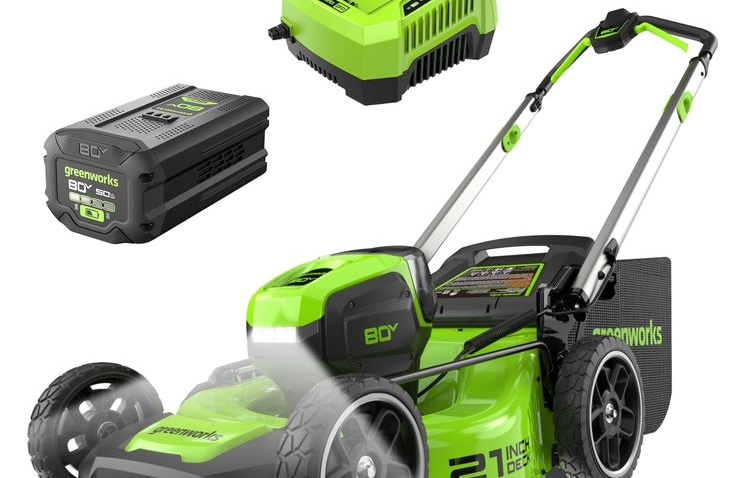
How to Charge Lawnmower Battery: Safe Guide
Preliminary Battery Inspection Steps
How to charge lawnmower battery? Before you hook up your charger, it’s key to inspect your lawn mower battery. These steps help avoid hazards and ensure effective charging.

Check for Visible Damage and Corrosion
Start by looking over the battery carefully. Check for cracks, leaks, or any signs of corrosion on the terminals. Damage or heavy corrosion may mean it’s time for a new battery.
Review the Manufacturer’s User Manual
Next, always read the user manual for your specific lawn mower model. It contains important info on how to charge the lawnmower battery safely and correctly. Follow these guidelines to prevent mistakes and maintain your safety.
Setting Up the Charging Area
To charge your lawn mower battery correctly and safely, you need the right charging environment. Follow each step to avoid dangers and ensure a smooth charging process.
Select a Well-Ventilated Space
Choose an open area with good airflow for charging. This helps prevent the buildup of harmful fumes, which can occur during the charging process. A well-ventilated garage or outdoor space works best.
Maintain a Safe Distance from Flammables
Keep the charging space clear of any items that can catch fire. Move gas cans, oils, and other flammable materials to a secure spot away from the charging area. This reduces the risk of a fire hazard while charging. Remember, safety always comes first when dealing with electrical equipment.
Connecting the Charger to the Battery
When it’s time to recharge, connecting your charger properly is critical for safety and battery life. Follow these simple steps to ensure safe and efficient charging of your lawn mower battery.
Turn Off the Mower Completely
First, ensure the mower’s engine is totally shut off. Check that all power switches are in the off position. This prevents accidental starts and potential injuries during the charging process.
Attach the Connectors to the Correct Terminals
Next, connect the charger clips to the battery terminals. The red clip goes to the positive ‘+’ terminal, while the black clip should attach to the negative ‘-‘ terminal. Correctly matching these is crucial to prevent damage.
Double-Check for Secure Connections
Lastly, give the connections a second look. Make sure that the clips are fully attached and not loose. A secure connection is necessary for a safe charge and to protect against short circuits.
Monitoring the Charging Process
When charging a lawn mower battery, constant supervision is essential to avoid mishaps. Here’s how you can effectively monitor the battery during the charging process:
Use a Timer to Prevent Overcharging
Setting a timer is crucial. Overcharging can damage the battery and reduce its lifespan. Make sure to set a timer according to the manufacturer’s guidance. This prevents the battery from charging more than necessary.
Regularly Check the Battery Status
While the battery charges, check its status frequently. Look at the battery’s temperature and ensure it’s not getting too hot. Overheating can lead to battery failure. Also, observe if the charging indicator shows normal behavior. Regular checks help detect any issues early, which can save both the battery and the charging system from potential harm.
Post-Charging Procedures
After you finish charging your lawn mower battery, you must follow important steps. These ensure safety and prolong battery life.
Safely Disconnecting the Charger and Battery
Do not rush when disconnecting your battery charger. First, ensure the charger is off. This prevents any electrical shocks or surges. Always remove the black clip first, followed by the red clip. This order helps avoid short circuits.
Proper Battery Storage Post-Charging
Store your battery in a cool, dry place. Avoid places that are too hot or cold. This keeps the battery in good condition. Make sure the storage area is not directly in sunlight. Also, avoid areas with extreme temperature changes.

Maintaining Lawn Mower Battery Health
Proper maintenance extends the life of your lawn mower battery and ensures consistent performance.
Charge the Battery Regularly
To keep your lawn mower battery in top condition, charge it regularly. Avoid letting it fully drain as this can reduce its lifespan. Aim to charge the battery after each use, especially if it’s low. This practice helps maintain battery efficiency and readiness for the next use.
Clean Battery Terminals to Prevent Corrosion
Corrosion at the terminals can impede the flow of electricity, which diminishes the battery’s effectiveness. Routinely check and clean the terminals. Use a wire brush to gently remove any corrosion. After cleaning, apply petroleum jelly to the terminals. This acts as a barrier against future corrosion.
Schedule Routine Checks and Maintenance
Regular checks are key to spotting potential issues before they become major problems. Inspect your lawn mower battery every few months. Look for signs of wear or damage. If you notice any issues, consider professional servicing. This ensures that any intricate problems are handled correctly and safely.
Regular maintenance not only helps in the smooth operation of your mower but also enhances safety by reducing unexpected failures.
Understanding Different Types of Mower Batteries
How to charge lawnmower battery? Choosing the right battery for your lawn mower is essential. Different batteries offer various features and capabilities. Here, we explore the most common types used in lawn mowers.
The Pros and Cons of Lead-Acid Batteries
Lead-acid batteries are widely used due to their affordability and reliability. They are easy to recycle and widely available. However, they are heavier and require regular maintenance. Regular checks are necessary to ensure optimal function.
They typically last between three to four years with proper care. But, they may suffer from quicker degradation if not maintained properly.
The Benefits of Lithium-Ion (LiFePO4) Batteries
Lithium-ion batteries, especially LiFePO4, are gaining popularity in newer lawn mower models. They offer several advantages over lead-acid batteries:
- Weight: They are much lighter, making the mower easier to handle.
- Maintenance: They are virtually maintenance-free, which saves time and effort.
- Lifespan: These batteries can last over 10 years, or up to 3,000 charging cycles at 80% Depth of Discharge.
Although they have a higher initial cost, their longevity and durability provide long-term savings. They perform well under various conditions, adding to their versatility in different mowing environments.
Lawn Mower Battery Safety and Regulations
How to charge lawnmower battery? When dealing with lawn mower batteries, understanding and adhering to safety standards is critical.
Adhering to Safety Standards and Regulations
Ensure you abide by important safety standards to keep yourself and your equipment safe. Familiarize yourself with guidelines like UL 2271 and UN/DOT 38.3 that apply to batteries. These standards cover aspects from design to transportation, minimizing the risk of mishaps.
Check batteries for certifications, confirming compliance with national or international safety criteria. These certifications show that the product has passed rigorous testing. Always follow rules set by the manufacturer when it comes to charging and maintaining batteries.
Recognizing and Addressing Safety Concerns
Stay aware of potential risks when charging lawnmower batteries. Overcharging, short-circuiting, or improper handling can lead to dangerous situations like fires.
Watch out for warning signs like unusual heating, smells, or discolorations during use or charging. If you observe these, stop the process immediately and consult a professional.
Take precautionary measures like using protective gear and keeping a fire extinguisher nearby when handling batteries. Dispose of old or damaged batteries properly to avoid environmental hazards and potential accidents.
To sum up, always prioritize safety by understanding regulations and recognizing warning signs during battery charging and maintenance. Stick to guidelines and equip yourself with knowledge to prevent battery-related incidents.

Commonly Asked Questions About Lawn Mower Batteries
How to charge lawnmower battery? When using lawn mower batteries, several questions often arise about their care and efficiency.
Recharging a Completely Dead Battery
Yes, you can recharge a totally dead lawn mower battery. Charge fully drained batteries as soon as possible to avoid damage. Prolonged inactivity might result in sulfation, complicating the recharge process.
Using a 12-Volt Charger for Lawn Mower Batteries
Most lawn mowers are compatible with a 12-volt charger. Check the charger’s compatibility with your battery’s voltage to avoid harm. Also, choose a charger with 10 amps or less to protect the battery.
The Risks of Overnight Charging
Charging a battery overnight comes with risks if using an older charger without auto-shutoff features. These could overcharge the battery, leading to potential dangers. Always supervise the charging process where possible.












Leave a Reply